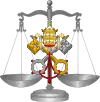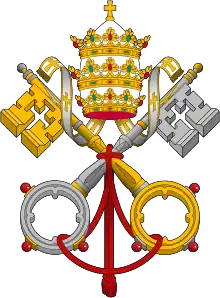 |
| Part of a series on the |
| Canon law of the Catholic Church |
|---|
|
|
.jpg.webp)
Mendicant orders are, primarily, certain Roman Catholic religious orders that have adopted for their male members a lifestyle of poverty, traveling, and living in urban areas for purposes of preaching, evangelization, and ministry, especially to the poor. At their foundation these orders rejected the previously established monastic model. This model prescribed living in one stable, isolated community where members worked at a trade and owned property in common, including land, buildings and other wealth. By contrast, the mendicants avoided owning property at all, did not work at a trade, and embraced a poor, often itinerant lifestyle. They depended for their survival on the goodwill of the people to whom they preached. The members of these orders are not called monks but friars.
The term "mendicant" is also used with reference to some non-Christian religions to denote holy persons committed to an ascetic lifestyle, which may include members of religious orders and individual holy persons.
Main mendicant orders
The Second Council of Lyon (1274) established four main mendicant orders, created in the first half of the 13th century:
- The Order of Friars Minor (Franciscans)
- The Carmelites (Order of the Brothers of the Blessed Virgin Mary of Mount Carmel)
- The Order of Preachers (Dominicans)
- The Augustinians (Hermits of St. Augustine)
Other mendicant orders
The other mendicant orders recognized by the Holy See today are the
- Trinitarians – Order of the Most Blessed Trinity, sometimes called the Red Friars, founded 1193.
- Mercedarians – Order of the Blessed Virgin Mary of Mercy, founded 1218; and after a reform Discalced Mercedarians.
- Servites – Order of Servants of Mary, founded 1233 by the Seven Holy Men of Florence, Italy. The order was suppressed by the Second Council of Lyon in 1272, on the basis of the restrictions in the decree Ne nimium of 1215; the suppression was not fully enforced and was subsequently overturned by Pope Benedict XI in his Bull, Dum levamus, of 11 February 1304.[1]
- Minims – Hermits of St. Francis of Paola, founded 1436.
- The Order of Friars Minor Capuchin
- Hospitaller Order of the Brothers of Saint John of God – founded in 1572 by Saint John of God for the care of the sick.
- Order of the Poor Clerics Secular of the Mother of God of the Pious Schools (Piarists) - founded in 1617 by Saint Joseph Calasanz takes care of the education for the poor and little children.
- Order of Bethlehemite Brothers, founded in Guatemala in 1653 and suppressed in 1820. They were refounded in 1984.[2]
Like the monastic orders, many of the mendicant orders, especially the larger ones, underwent splits and reform efforts, forming offshoots, permanent or otherwise, some of which are mentioned in the lists given above.
Former mendicant orders
Mendicant orders that formerly existed but are now extinct, and orders which for a time were classed as mendicant orders but now no longer are.
Extinct mendicant orders
- Ambrosians or Fratres sancti Ambrosii ad Nemus, existed before 1378, suppressed by Pope Innocent X in 1650.
- Fraticelli of Monte Malbe, founded at Monte Malbe near Perugia in Italy in the 14th century, by the end of the century they had dispersed.
- Hospitallers of San Hipólito (Saint Hippolytus) or Brothers of Charity of de San Hipólito were founded in Mexico and approved by Rome as a mendicant order in 1700. In the 18th century they were absorbed by the Brothers Hospitaller of Saint John of God.
- Jesuati, or Clerici apostolici Sancti Hieronymim, Apostolic Clerics of Saint Jerome, founded in 1360, suppressed by Pope Clement IX in 1668.
- Saccati or "Friars of the Sack" (Fratres Saccati), known also variously as Brothers of Penitence and perhaps identical with the Boni homines, Bonshommes or Bones-homes, whose history is obscure.[2]
- Crutched Friars or Fratres Cruciferi (cross-bearing friars) or Crossed Friars, Crouched Friars or Croziers, named after the staff they carried which was surmounted by a crucifix, existed by 1100, suppressed by Pope Alexander VII in 1656.
- Scalzetti, founded in the 18th century, suppressed by Pope Pius XI in 1935.[2]
Orders no longer mendicant
- Jesuits or Society of Jesus, founded in 1540, and for a time considered a mendicant order, before being classed instead as an Order of Clerics Regular.
Orders considered heretical by the Catholic Church
- The Dulcinians
See also
References
- ↑ Griffin, Patrick. Order of Servites. The Catholic Encyclopedia. Vol. 13. New York: Robert Appleton Company, 1912. 19 Aug. 2013
- 1 2 3 Giancarlo Rocca (dir.), Dizionario degli Istituti di Perfezione, Edizioni Paoline, Roma, vol. V, 1978, col. 1185.
External links
- Audience of Benedict XVI, 13 January, 2010
- Order of Preachers – Dominicans
- Herbermann, Charles, ed. (1913). . Catholic Encyclopedia. New York: Robert Appleton Company.
- . Encyclopædia Britannica (11th ed.). 1911.
